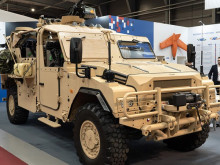Gen. Jaroslav Míka: The price for the F-35 is the same for us as for the Belgians, Dutch or Danes
With the approaching deadline for the government's decision on the acquisition of the 5th generation F-35 Lighting II fighter aircraft, information about the need for them to develop the capabilities of the Czech Army is proliferating, but there are also critical voices that talk about the high financial costs, the need to build infrastructure structures for the air force, and there is also talk of personnel problems. For these reasons, we have invited Brigadier General Jaroslav Míka, who is not only the Deputy Director of the Force Development Section of the Ministry of Defence of the Czech Republic, but is also the head of an integrated working team called the Tactical Air Force of the Czech Republic, which is tasked with planning and finding the right solution for the entire transition of the supersonic tactical air force of the Czech Air Force into the fifth generation. General Míka was also the commander of the 21st Tactical Air Force Base Čáslav in 2020-2022 and in 2009 he was the commander of the first ever fighter unit of the Czech Air Force deployed abroad, namely in the Baltic States.
Video: Interview with the Deputy Director of the Force Development Section of the Ministry of Defence, Brig. Gen. Jaroslav Míka / CZ DEFENCE
The biggest topic for discussion is undoubtedly the question of the final price of the F-35 Lighting II and its configuration. We wondered, therefore, what the actual price will be and whether the army will not receive these aircraft in an obsolete configuration when the new aircraft are delivered, as some politicians believe? According to General Míka, everything is transparent. The price for the aircraft is set the same for everyone for the current year and at the time of delivery the customer will receive the most modern version. "You find from public sources, from the US Congress, exactly how much money the US government is asking for in 2023 for the F-35 aircraft. So we know the price, it's under $92 million a piece," General Míka says in the interview.
The advantage of the negotiated contract for the acquisition of the supersonic jets, he says, is the type of contract. It is a government-to-government system, where specifically for the purchase of military equipment with the United States, the deal is always handled in the form of so-called Foreign Military Sales (FMS). "It is subject to a congressional approval process, where Congress is the last institution to approve the sale of that military equipment to foreign customers. The transparency of that process is that it's actually a public matter. That's one thing, and the other thing is that this process guarantees that the Czech Republic, or any other foreign customer, will get exactly the same price that the US armed forces buy from each manufacturer," the general explained.
Jaroslav Míka assumes that after the government's decision the process will be similar to the US. That is to say, that a similar set of information will be published in the Czech Republic. "There is nothing secret about it and on the contrary I would say that we can be proud of what we have achieved during the negotiations. As I said, the price is the same as when the US government buys it for itself, it buys it for us. The price is the same for the Belgians, the Dutch or the Danes," General Míka said in the interview.

The whole negotiation is in government-to-government mode. According to General Míka, the reason for this is that for such a strategic project, the Czech Republic has a political guarantee from the state from which it is purchasing the equipment, which means that there is no risk of bankruptcy of private suppliers or setting additional conditions or failure to meet deadlines. This is why individual aircraft manufacturers were not approached, but the governments of their home countries. Surprisingly, this process did not result in the possible acquisition of the F-35 as the most expensive option. "In English, this is called 'scale economy'. It is economy of quantity or economy of volume. Consider that over three thousand F-35s are already on order today and no other aircraft is on order today in that quantity. All other bids for the four 4.5 generation aircraft have come out in the order of almost the same. However, the military recommendation was formed quite logically. First, what are the missions, what should the theater of war of the future look like, what capabilities are required. Then, based on the capabilities, we identified the aircraft that could meet the future, and then we took the economic aspect to it," explains General Míka the method of work of the expert team of the Czech Armed Forces.
On the basis of the brief thus created, the various governments in whose territories the manufacturers produce the aircraft were then contacted under the so-called request for government to information (RFGI), and the quotations were then compared on the basis of their responses. "If we went purely by public sources and the Internet, or did our own investigations, where and for how much the individual aircraft were sold, the offers of the parties would not differ substantially," says Jaroslav Míka, who also confirmed in the interview the information given to journalists by Defence Minister Jana Černochová that the amount of the annual payment for this aircraft would not exceed 10% of the budget of the Ministry of Defence. "It will be under 10%. The exact figure will be announced by the government at the meeting and I am convinced that the exact figure will be told to the public. This is not a question of hiding anything because of damage to the security interests of the Czech Republic. I can safely say to the public that the numbers we are talking about are in the upper limit and the specific numbers will then be lower," the general clarified.
Another area that has been increasingly discussed and clarified recently is the amount of costs that will have to be invested in the infrastructure of the airports in Čáslav and Pardubice. "Of course, we have our study. We know that we are able to build it under completely standard conditions, as they build elsewhere in Europe, for example in Belgium or Germany," explains Brigadier General Míka the price for all the work.

The issue of having enough pilots and ground personnel in the Air Force to operate the F-35s is also a much-discussed issue in the media. "Today we use thirty-eight machines in the tactical air force. We're going to have 24. So this way it would seem that it's actually a reduction. However, we know that everything is done with perspective," the general said, adding that there is a planned transition period from the older system to the new system and the two systems will be linked. This will probably be the most challenging phase for the tactical air force. According to Jaroslav Míka, there will ultimately be a reduction in the number of pilots. "As for the personnel that will remain on the base, we do not expect the total number of people on the base to expand," Gen. Míka.
Although the current public and professional discussion does not admit that the government's decision to purchase the 5th generation supersonic aircraft should not happen, we wondered whether the army is prepared for the possibility that the government, due to many external aspects, will not decide in favour of purchasing the F-35 aircraft. "The military is always prepared. Of course there are other alternative solutions and we are not saying we will be like petulant children. But it would definitely be against our military recommendation, which we firmly stand by," says General Míka in an interview, according to whom the possible acquisition of the F-35 aircraft will bring new capabilities to our army in terms of the technical level and equipment of the machine. General Míka believes that this is a generational transition, where the aircraft's capabilities are difficult for an adversary to detect. "It's obviously all the sensors that the aircraft has on it, plus all the data fusion. And then the aircraft is able to operate in such a difficult environment for 4th and 4.5th generation aircraft, such as the war Russia is fighting against Ukraine today, because there you see that the current aircraft are not able to operate without being compromised and having major losses. The main thing is that we will clearly declare that we have this capability. Nobody wants a war, we want to have that deterrent effect for a potential adversary so that they do not think of attacking us - not only as the Czech Republic, but also as the Alliance, because we have the capability to operate in their air defence environment. For the Czech army as a whole, it means that this is another sensor that not only receives that information, but more importantly, can receive it further than any other sensors can get. It gives us time to better prepare for everything. In addition, the data is not just raw data, but it will be analyzed immediately and then with the digitization of the army and the whole Alliance, this information will be disseminated so that all participants in a potential battlefield will have a sufficient overview of what is happening even further than we are able to see today," says Gen. Míka.
We wondered whether and to what extent the large amount of data and information obtained in this way, not only for the needs of the Air Force, but also for other parts of the army, will change the current system of command, control and coordination of fire. "I can say with a clear conscience that as not only the military but also society is evolving just in digitalization, artificial intelligence and other technologies, we as an army have to respond to that and we will change that command and control system regardless of the F-35 aircraft. But the F-35 is exactly the benchmark that we have to look towards to take advantage of the digitalised command, control system," the general said, adding that this new approach will be subordinated to the acquisition of other platforms such as tanks, BMPs, guns, the air defence system so that everything is connected. In the context of the F-35 acquisition, there is also talk of air defence support, which rests on three pillars. "One pillar is sensors. The second pillar is missiles on the ground. And the third is tactical aircraft. Specifically, the F-35, in addition to ballistic missiles, can destroy all other assets, whether they are drones or cruise missiles, which are a big nut for ground-based air defence because they fly low to the ground," Jaroslav Míka said.

The negotiation process for the acquisition of new supersonic aircraft for the Czech Air Force is taking place in diametrically different conditions than the previous lease of JAS-39 Gripen aircraft. Also important is the army's ability to submit military recommendations to the government, which then makes the political decision on whether and which aircraft to acquire. "The process at the time was very much politically influenced in terms of whether it was going to be American or European aircraft. I can say for myself that we have now given a clear military recommendation without any interference from any politician. The commissioning of the military recommendation came under the previous minister, under the government that is in opposition today, and the process remained continuous, and we de facto ended the process itself in December 2021, when the minister or the new government came in. Of course, we cannot say directly as a military, we want this particular type. However, if it turns out that we need the most effective solution for the future, which is a fifth-generation aircraft, then unfortunately there is no choice. The only serial aircraft available on the market is the F-35," says Brigadier General Jaroslav Míka.
In the interview with General Míka, we also discuss the 2% of GDP spending on defence, talk about the experience with the JAS-39 Gripen aircraft, how the military decision was prepared and other information about the key government decision to acquire the F-35 Lighting II. To learn more, listen to the full interview at the top of this article.





















